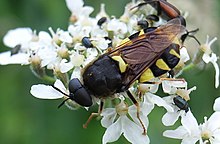Stratiomys chamaeleon
| Stratiomys chamaeleon | |
|---|---|

| |
| Scientific classification | |
| Domain: | Eukaryota |
| Kingdom: | Animalia |
| Phylum: | Arthropoda |
| Class: | Insecta |
| Order: | Diptera |
| Family: | Stratiomyidae |
| Subfamily: | Stratiomyinae |
| Tribe: | Stratiomyini |
| Genus: | Stratiomys |
| Species: | S. chamaeleon
|
| Binomial name | |
| Stratiomys chamaeleon | |
| Synonyms | |
| |
Stratiomys chamaeleon, the clubbed general, is a European species of soldier fly. [9][10][11]
Distribution
[edit]It has a widespread Palearctic distribution, occurring in Southern Europe and parts of Asia. It has a very restricted range in Britain, where it is regarded as endangered.[12]
Ecology
[edit]In Britain larvae have been found in tufa-rich flush systems. Elsewhere larvae of Stratiomys chamaeleon have been recorded from the margins of freshwater ponds and spring pools as well as from semi saline conditions. Adults are on the wing from late June to the middle of August, with peak occurring in mid to late July and feed on nectar, mostly from umbellifers.[12]
References
[edit]- ^ a b Linnaeus, C. (1758). Systema naturae... Ed. 10, Vol. 1. Holmiae [= Stockholm]: L. Salvii. pp. 824 pp. Retrieved 14 November 2022.
- ^ Sulzer, J.H. (1761). Die Kennzeichnen der Insekten. Zurich: Heidegger. pp. xxviii + 203 + 67 pp., 24 pls.
- ^ Scopoli, I.A. (1763). Entomologia carniolica exhibens insecta carnioliae indigena et distributa in ordines, genera, species, varietates. Methodo Linnæana. Vindobonae [= Vienna]: Trattner. pp. [30] + 420 pp. Retrieved 23 June 2021.
- ^ Meigen, J.W. (1804). Klassifikazion und Beschreibung der europäische n zweiflugeligen Insekten (Diptera Linn.). Erster Band. Abt. I. Braunschweig [= Brunswick]: Reichard. pp. xxviii + pp. 1–152, Abt. II. vi + pp. 153–314.
- ^ Macquart, P.J.M. (1826). "Insectes diptères du nord de la France. Asiliques, bombyliers, xylotomes, leptides, stratiomyides, xylophagites et tabaniens". Mem. Soc. Sci. Agric. Arts, Lille. 1825: 324–499, 3 pls.
- ^ Jaennicke, J.F. (1866). "Beiträge zur Kenntniss der europäische n Stratiomyden, Xylophagiden u. Coenomyiden sowie Nachtrag zu den Tabaniden". Berliner entomologische Zeitschrift. 10 (1–3): 217–237. doi:10.1002/mmnd.18660100114. Retrieved 14 March 2023.
- ^ Wulp, F.M. van der (1885). "On exotic Diptera. Part 2". Notes from the Leyden Museum. 7: 57-64–65-86. Retrieved 22 November 2022.
- ^ Becker, T. (1887). "Beiträge zur Kenntnis der Dipteren-Fauna von St. Moritz" (PDF). Berliner Entomologische Zeitschrift. 31: 93–141. doi:10.1002/mmnd.18870310120. Retrieved 4 April 2023.
- ^ Stubbs, Alan E; Drake, Martin (2014). British Soldierflies and their allies (an illustrated guide to their identification and ecology) (2 ed.). Reading: British Entomological and Natural History Society. pp. 528 pp, 20 plates. ISBN 9781899935079.
- ^ Woodley, N.E. (2001). "A World Catalog of the Stratiomyidae (Diptera)". Myia. 11: 1–462. Retrieved 7 December 2022.
- ^ Zeegers, T.; Schulten, A. (2022). Families of Flies with Three Pulvilli: Field Guide Northwest Europe. Graveland: Jeugdbondsuitgeverij. pp. 256pp. ISBN 9789051070682.
- ^ a b Howe, Mike; Howe, Liz (1995). "The soldier fly Stratiomys chamaeleon on Anglesey and the Black Isle". Dipterists Digest (Print). Second series. 2 (1). Dipterists Forum: 24–28. ISSN 0953-7260.
Text is available under the CC BY-SA 4.0 license; additional terms may apply.
Images, videos and audio are available under their respective licenses.
